Galaxy Science Fiction, October 1952: A Retro-Review
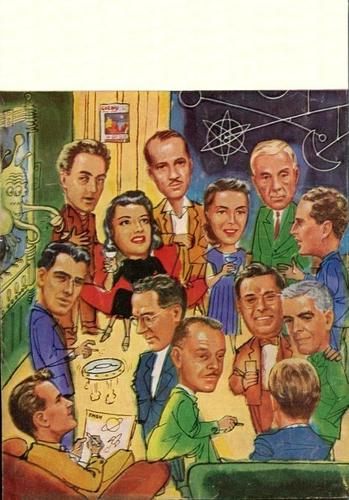 |
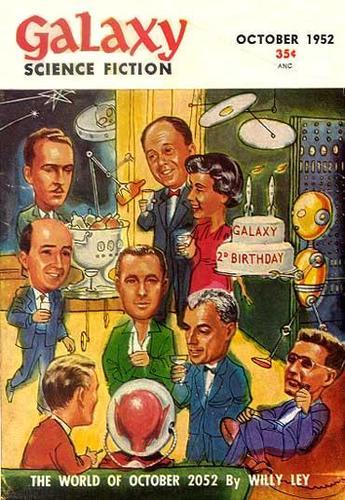 |
Galaxy celebrated its second birthday (and start of its third year) with a cover depicting some of its staff and contributors (illustrated by E. A. Emshwiller). The artwork wrapped around the back (interrupted by the spine) and included a “key” on the inside cover to identify each person, including the robot and alien.
Editor H. L. Gold is on the left on the front cover, halfway down the picture, shown in a blue suit and holding a cup. (Click on the images above for bigger versions.)
“Baby is Three” by Theodore Sturgeon — Gerry is a teenager who’s struggling with his past. He visits a psychiatrist to help him understand who he is. What ensues is a series of flashbacks to Gerry’s past. Gerry lived with other children and an older man, but the children all had special abilities, such as teleportation or telekenesis. Gerry didn’t think he had such talents, yet he was chosen to be part of them. After the man died, the children were left in a state of limbo, eventually leading them to a new home and a strange encounter that Gerry locked within himself. With the psychiatrist’s help, Gerry agrees to go back to that moment, to understand what happened and put together who he is.
This is an amazing story. I can’t say enough about it. The narrator’s voice is fantastic, and once again, Sturgeon proves he was a master of characters. It read much more like fantasy to me; replace the words teleportation and telekenesis with magic, and that almost takes care of it. It was chosen by SFWA as one of the top ten pre-1965 novellas (#5 actually), and was published in The Science Fiction Hall of Fame, Volume Two (Volume One contained only short stories.) The novella was later reconstructed into a novel titled More Than Human, published in 1953.
“Zen” by Jerome Bixby — David Koontz is part of a team exploring asteroids for any signs of life. Surprisingly, David finds a female Zen — an intelligent and long-living species. To date, the only Zen anyone has ever seen is their crewmate, Yurt. And no one is more excited by the discovery than him.
“Zen” is cute, just like the alien being itself — a lighthearted story that follows the powerful Sturgeon. Bixby planted many seeds in the science fiction field. He wrote two episodes of Star Trek, and he wrote a short story titled “It’s a Good Life” that was adapted for a Twilight Zone episode of the same name; it’s about a boy with the power to change whatever he likes with his mental powers, so everyone has to call everything he does “good” or they might end up as a jack-in-the-box (or worse).
Another interesting contribution from Bixby was his screenplay for It! The Terror from Beyond Space, which inspired Alien.
“Wait for Weight” by Jack McKenty — Dr. Brinton works at the director of the Rocket Research Station, working on spaceflight. The team has encountered failure after failure for years, and now Dr. Brinton has to explain their “progress” to a visiting senator.
It was interesting to read a story where achieving spaceflight wasn’t a simple matter — that even in the future, there were many failed trials.
Normally, I don’t cover the non-fiction articles, but I’ll take exception in this one. Willy Ley’s article “For Your Information” drew me in. In part of it, he speculates about the future, and I found this especially amusing:
Finally: I do think that the people a hundred years from now will still buy newspapers and read books. I also believe that these books and papers will be printed — presumably with a more lavish use of color than nowadays — on paper. I don’t believe in the ‘electronic device’ which replaces the newspaper, nor in the newspaper printed photographically on a piece of plastic the size of a special delivery stamp. All you have to do is insert it in the projector and the letters will appear on the ceiling of your bedroom. You can read it while having breakfast in bed. Damned inconvenient is all I have to say.
He did go on to make some good points about an electronic device — that you could mislay it, or it might break. Also, it might not be simple to record notes on, and how could you file items? Still, I wish I could go back in time and show him my Kindle Fire.
“Halo” by Hal Clement — A galactic being reports to its superior about not running its farm properly. One of its richest units is beyond a field of asteroids, preventing their kind from feeding off of it.
I appreciate any science fiction with alien beings who aren’t humanoids. This had a nice plot and an interesting conclusion.
“Tree, Spare That Woodman” by Dave Dryfoos — A pioneer family on an alien planet discovers their good friend, Cappy, died. Outside his shack, the trees are gathered close. The husband shares a secret with his wife to quell her apprehension- – that the trees attack when they sense fear. There are trees near their own home, and they are somehow creeping closer every moment.
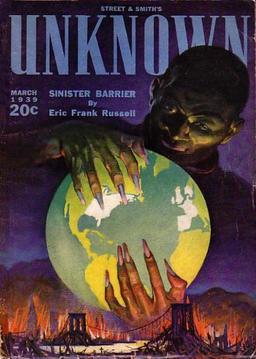 The characters come across as stock characters of a cliche western. Pa knows about danger and tells Ma to keep strong for the boy’s sake. Ma frets and stews about the danger anyway. And the boy runs amok. Beyond that, the ending seemed implausible.
The characters come across as stock characters of a cliche western. Pa knows about danger and tells Ma to keep strong for the boy’s sake. Ma frets and stews about the danger anyway. And the boy runs amok. Beyond that, the ending seemed implausible.
“Game for Blondes” by John D. MacDonald — Martin isn’t just drunk — he’s been in a state of drunknness for weeks. He’s trying to anesthetize himself after the death of his wife, which he caused through reckless driving. While he’s drifting through bars on New Year’s Eve, a trio of blonde girls stalk him. Though he tries to flee, they eventually capture him and take him to a place more bizarre than his drunken visions.
This story reads well and has strong emotion. Martin’s character seems quite real.
“A Little Oil…” by Eric Frank Russell — A small crew returns to Earth from their mission to a nearby solar system. At least, they hope they’re returning. Unfortunately, they can’t be certain that the star they’re moving toward is the sun. They experience of mix of anger, fear, boredom, and desperation. The only crewman who seems immune to it is Bertelli, a man who seems to serve no purpose at all, other than bungling things or occasionally entertaining them in mock talent shows. Or maybe there is a reason Bertelli was chosen, some purpose that the crew simply can’t identify.
I liked the grim reality of space travel in this story; it isn’t fun, and it isn’t safe, but it’s exploration. Bertelli’s character is the only one that really stands out; the rest blur together a bit. But I think that is intentional.
There’s an interesting legend about Russell — that his story Sinister Barrier brought about the creation of John W. Campbell’s Unknown (the story appeared in the premier issue). If it’s true, think about the implications — that the story is so well written and different that, rather shoehorn it into Astounding, a science fiction magazine, Campbell launched an entirely new magazine to make a home for it.
Matthew Wuertz’s last retro reviews for us were the September 1939 issue of Unknown, and the September 1952 issue of Galaxy Science Fiction.
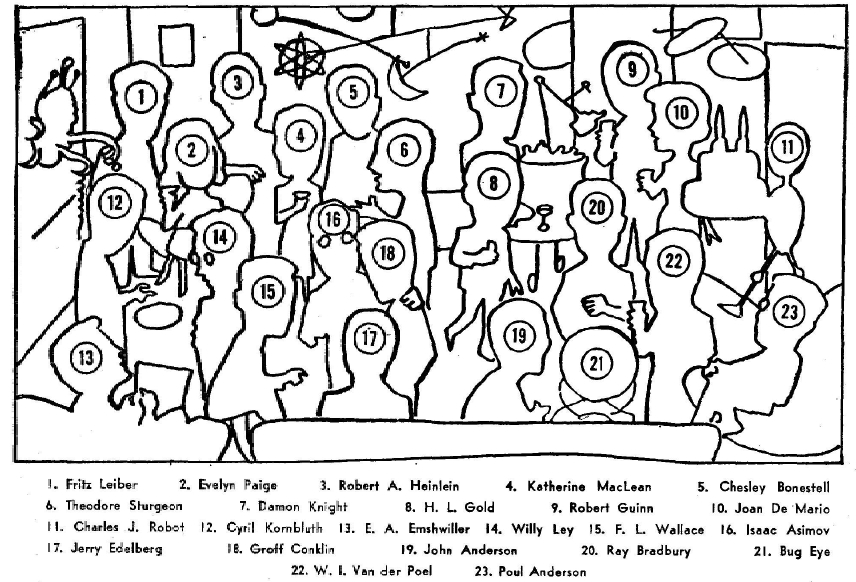
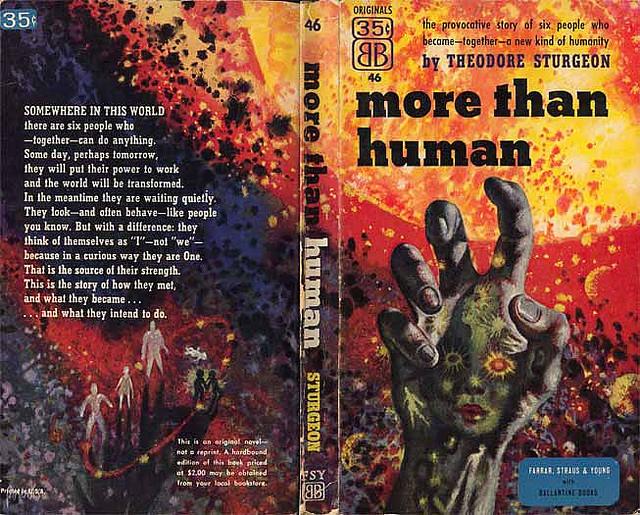
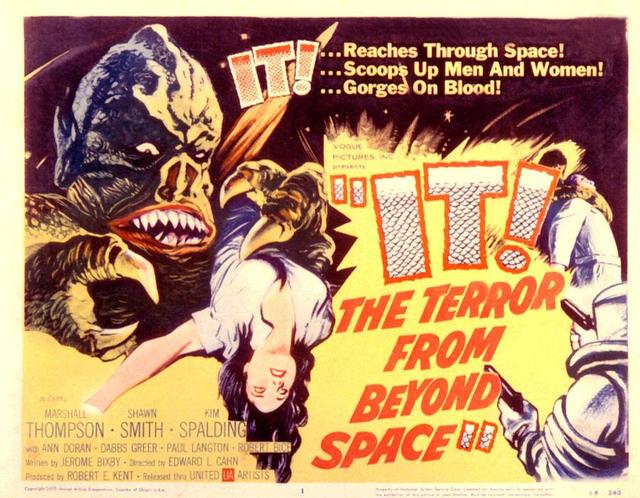
Didn’t anyone in the editorial offices ask whether this cover would actually help to sell copies?
But that would be my objection to some other Galaxy cover art, if not to the degree if this one. Some of the other issues had “cute” covers that wouldn’t, I’d have thought, attract casual buyers.
I do understand that they wanted to break away from the trashy exploitation covers of many of the sf pulps.
Someone seems to have thought: If the Saturday Evening Post can, occasionally, run sf (Heinlein, Bradbury), then why not produce a science fiction magazine that will look like the SEP or the New Yorker of imaginative literature?
So far as this reader is concerned, the result was a magazine whose contents were often as unreadable — though for different reasons — as the mags that screamed “Pulp!”
Major Wootton, I liked the cover; it celebrates two years of publishing amazing science fiction. Granted, it was a bit different, but I don’t know if it affected sales by this point. But Galaxy also likes to have covers that reflect holidays, like Independence Day, so this seems in range with that.
The actual thoughts behind creating the magazine was to get away from westerns thinly disguised as science fiction. Gold wanted science fiction that explored what might happen and the implications of those possibilities on society. He also liked to challenge injustices of the day, such as sexism and racism, through its writers.
Which issues have you read? And which stories did you find unreadable? I can’t say I enjoyed every story published, but there is a lot of great content in Galaxy. Just from this issue alone, find a copy of “Baby is Three” somewhere (if you haven’t read it already); I’m curious what you think of it.
Matthew, any chance you could provide the key to who the people on the cover are? I can identify Asimov and Leiber and made some guesses about a few others, but for the most part, I’m at a loss as to who they are.
I’ll mention no particular stories, but I recently read around a lot in about 15 of Groff Conklin’s anthologies, as well as selections by other editors, and found that fairly often stories not to my taste were from Galaxy. They seemed to me, as far as I got reading them, to be the sort of “clever,” “sophisticated” thing that makes me think of martinis served on Scandinavian Modern living room tables. But the magazine printed some things I’d like too.
The cover you reproduced would have interested me for faanish reasons, but I doubted that it would draw new readers.
westketih – Fair enough – I added the key.
Major Wootton, I suppose it’s not for everyone. But if you haven’t read “The Fireman” by Bradbury or “Baby is Three” by Sturgeon, you might check those two out. At least you found some things you like from them. 🙂
If I could have a complete 1950’s run of any any major SF magazine, i would pick Galaxy, hands down.
Thomas, I’m working on completing my collection – year by year. 🙂
Thank you. Much appreciated.
GALAXY had lots of goofy, witty covers in its 1950s run, and its success is a matter of record. They must have known what they were doing.
MORE THAN HUMAN is an amazing piece of work–won the International Fantasy Award deservedly, etc. But somehow I like “Baby Is Three” better than I like the middle section of the novel. Sturgeon made a significant change or two for the book version. But fans of the recent Netflix series SENS8 might want to check out MTH.
Archive.org has a lot of scans of the 1950s run of GALAXY (along with other old ‘zines).
James,
I find those covers rather endearing. 🙂
I haven’t read More Than Human, but it sounds like between it and “Baby is Three” I might have read the better of the two.
For some reason, this makes me think about the two versions of “Flowers for Algernon” by Daniel Keyes; both are great, but I prefer the short story over the novel.
Thanks for the link!
Major Wooton: I respect your right to have your own taste in literature, but I challenge you to name any story in Galaxy that is unreadable, and describe why it is so. I have been following Matthew for a year or so on this journey, and there have been a few clunkers (not many!), but nothing that I remember could be classified as unreadable.
My collection of Galaxy is complete. I don’t have any of the later slick, fanzine issues, but I do have all of the digests, and I consider that to be complete. I need to read four of them to catch up to where I began to follow you, Matthew, and I hope to have that done by the end of summer.
This particular magazine traveled with me on my summer vacation, so I read while camped in countless parks from California to North Dakota. I even spent a night in Nebraska. Nebraska is an actual place! Who knew?
I came into “Baby is Three” with high hopes, and I was not disappointed. Psychological thrillers are not my thing, but Mr. Sturgeon really captures the readers while they watch this one unfold. The characters are believable and the narration is excellent. I wasn’t sure if the poor psychiatrist would keep his professional demeanor as Gerry unfolded his life to him. Great stuff, and a great ending.
Could this be classified as a psychological thriller?
I don’t know if I would call “Zen” lighthearted, but it was definitely down a gear or two down from “Baby.” It was funny to watch how sympathy changes to real concern after we see what the issues are with letting the Zen run wild.
Having good stories in the magazine is the highest priority of course, but placement is also crucial. After such a stunning story like “Baby is Three,” Mr. Gold did well to give the readers something that unfolds a little easier, and gets them ready to move on to the next one. If he had reversed the order of the two stories, I think it would have been less effective.
In my real life as a school band director, our final concert last spring featured a super-serious compilation of music from “The Dark Knight,” followed by the joyous “The Stars and Stripes Forever.” The audience got to experience both pieces and leave happy. Had I reversed that order…yikes.
Thanks for the side notes about Jerome Bixby. I always find those interesting and I enjoy the book covers and movie art. The extra effort is noted, Matthew 🙂
“Wait for Weight” was really just a punch line with a story attached to it. I did enjoy the solution to the fuel problem, but I am not sure it justified the entire narrative. Throwing politics into the mix did give this story some needed intrigue. I think there was some fascination with unique shapes, such as tesseracts and mobius strips, in the fifties. I remember one story (I am sure I could never find it again) from an early issue of F&SF that was similar to this, only the ultimate solution to the main problem was a klein bottle.
I think Willy Ley was dead on about printed books. Electronic devices are inconvenient and have to be charged. I like my books, and I only collect and read printed magazines. Forgive me, John, but I have not read any fiction on the Black Gate Website since the magazine stopped issuing printed copies. I have, however, read and enjoyed every word of the printed BG. Isaac Asimmov (again, in F&SF) described a book as a device that uses no energy, can be paused, rewound, or fast forwarded instantly, and conjures up images better than any television could produce. He was comparing a book favorably with a VCR (new at the time), and I think the logic holds well with Kindles and such.
I loved “Halo.” It took me a while to figure out what was going on. Personification of planetary bodies is always fun, especially when humankind gets to play spoiler in their plans.
“Tree” is very much a transplanted (get it?) Western. The premise is good but the character development is poor and the ending is a head shaker. All this story needs are several lengthy descriptions of the wife’s body and this could have been a Dwight Swain story from one of Ray Palmer’s trashy pulp magazines from the same era.
“Game for Blondes” seems like a typical male fantasy story at the beginning (oh no, more Palmer material…?) but unfolds nicely into something much more intelligent and thoughtful, with a nice ending.
I also enjoyed “A Little Oil,” but I was amused at how such trifling matters like navigation are so easy now, and if we do ever enter into an age of interplanetary spaceflight, navigation will be child’s play with the technology we have available even now. This one was kind of predictable, but I enjoyed it nonetheless.
As I said, I own a full run of Galaxy (to my standards), but I do not own a single copy of Unknown. Back issues of Unknown seem to command a premium price, and, let’s face it, the cover art just isn’t very cool (if there is any at all) on most of them. I have heard that it is the fantasy equivalent of Galaxy. If that is the case, I had probably better hunt down a few issues.
Thanks, Matt. See you next month.
Gus,
Glad you enjoyed the issue as well, especially “Baby is Three”. I’ve heard there’s an art to arranging stories in a magazine or anthology – one of the skills an editor. And Gold was spot-on with the order in this issue.
The one issue I read of Unknown was good stuff; yes, it’s more costly to track down, but it’s not completely unreasonable. Getting a full run might be, though (I only own two right now).
[…] (Cover from “Black Gate – Adventures in Fantasy Literature” – Post by Matthew Wuertz of July 5, 2015) […]